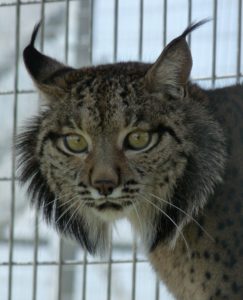Genetic erosion following extreme population declines can become an added burden for the recovery of endangered species. In a study just published in Genome Biology based on whole genome sequences of the Iberian lynx my colleagues and I report extremely low levels of genetic diversity and an excess of deleterious variants as major consequences of serial population contractions. Genomic studies of endangered species like this are providing insights into patterns of genomic erosion and how they can affect species viability. Hopefully, genomics will also contribute to saving species from extinction, adding a new tool to the species conservation toolbox.

We are in the midst of an alarming global biodiversity crisis. Species in all realms of life are becoming extinct at rates unprecedented in recent history and comparable to those of the other five mass extinctions recorded in geological history. Alleviating and eventually reverting this trend is one of the big challenges humanity is currently facing.
Conservation actions are wisely being directed to mitigating the causal processes of destruction, most related to human activities (overexploitation, habitat destruction, pollution and the introduction of exotic species). At the same time, a relatively small proportion of endangered species are receiving special attention, and a few have been saved from an imminent extinction thanks to focused conservation efforts.
However, a worrying possibility is that some species may not be able to persist, even if we eliminate all the direct threats, due to genetic deterioration accumulated during their decline.
Such deterioration has two main components: i) loss of genetic diversity –the raw material needed for adaptation by natural selection; and ii) poor health and fertility, including a high incidence of genetically determined disorders and abnormalities. Instances of genetic defects in highly endangered vertebrate populations include poor semen quality and several abnormalities in the Florida panther and chondrodystrophy – a genetically determined form of dwarfism – in California condors.
The Iberian lynx is one emblematic example of species at the brink of extinction. The species suffered a dramatic decrease during the second half of the 20th century that bottomed out at less than 100 lynxes in two isolated populations in 2002. Previous work suggested a low genetic diversity, low fertility and high incidence of likely genetic disorders (for example, idiopathic juvenile epilepsy), especially in the smallest and most isolated population in Doñana National Park (Southwestern Spain). Fortunately, the species is now recovering after 14 years of intensive conservation and management, with a 2015 census estimating more than 400 lynxes in the wild.
In our recent study based on whole genome sequencing of the Iberian lynx my colleagues and I characterized in detail the variation across its genome and reconstructed the demographic and evolutionary history of the species. We found the lowest genome-wide and species-wide diversity reported for any species, including some other highly endangered species like the cheetah, the Tasmanian devil, or the crested ibis. Low diversity extends to those functional elements of the genome – genes – that should contribute most to adaptive potential.
Moreover, a large proportion of the variation that is observed in protein coding sequences is likely deleterious, meaning that they probably negatively affect the function of the corresponding proteins, and could thus be limiting survival and reproduction. These kinds of variants rarely become abundant in large populations due to natural selection, but this purifying process becomes less effective in small or bottlenecked populations.
We also describe several other aspects in which the genome of the Iberian lynx has been shaped by demographic declines. These include extended linkage disequilibrium, reduced GC-biased gene conversion, and high fixation rates of transposable elements, most notably in places where they can affect function (insertions in sense within genes), another signature of a less effective purifying selection.
How did the genome of the Iberian lynx become so eroded? A likely answer provided by the study is that the decline suffered by the species during the 20th century was just the last one of a series of population crashes, that included one only around 300 years ago. Low population sizes and serial bottlenecks are the best recipe for extreme genetic erosion.
Finally, the study also reveals a recent divergence from its closest relative, the Eurasian lynx, and that the two species did not become immediately isolated from each other, but continued to exchange genes until recently. This finding could encourage the use of the Eurasian lynx as a source to boost diversity in the Iberian lynx through assisted adaptive introgression, although such drastic measures would first require a careful evaluation of the associated risks and benefits.
A legitimate and timely question is to what extent genomic knowledge and resources will directly benefit endangered species conservation and increase their chances of survival. Genetics is already helping, so the question becomes: what can genomics provide beyond what can be gained with a few old-fashioned – and cheap – molecular markers?
One obvious response is that it provides more powerful and informative tools to manage the species through controlled crosses and translocations. But most notably, genomics can extend the current goal of maximizing diversity and minimizing inbreeding, to the reduction of the incidence of those genetically-determined traits that are most limiting recovery, like the chondrodystrophy in California condors or the juvenile epilepsy in Iberian lynx.
Genomic analyses of endangered species are just beginning and will remain out of the reach for most endangered species for some time, but leading research on the genome of emblematic and actively managed species like the Iberian lynx should shed light on the intricate ways in which their genomes are modified by demographic declines, and on how this in turn affects their survival and reproduction and, ultimately, their endurance in a changing world. The few endangered species ahead in the road of genomics, like the Iberian lynx, will also become the touchstones on which to gauge the real impact of genomics in species conservation.
- Genomics and the conservation of species: insights from the Iberian lynx - 14th December 2016
Comments